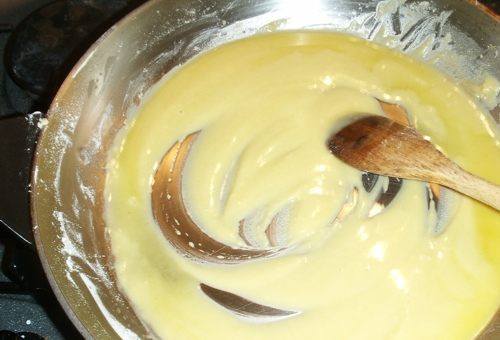So… The Turkey is golden brown and juicy. The Stuffing is crispy on top while savoury and moist inside. The Mashed Potatoes are light and fluffy and buttery. The Pudding is steamed to a ‘T’… And there’s just the Gravy left to make, to round out the perfect Christmas Family Feast!
 Here is a perfect ‘Blonde’ Roux – ideal for Turkey or Chicken Gravy. Note the telltale
Here is a perfect ‘Blonde’ Roux – ideal for Turkey or Chicken Gravy. Note the telltale
white, lacy foaming fringe just beginning to show around the edges of the mixture.
Ever get the best-yet festive dinner on the table only to have the gravy come put too thick or too thin, or just downright, irredeemably lumpy? Tried throwing it in the blender only to be left with more, though smaller, lumps? Did your Gravy come up pasty tasting or short on flavour? You can avoid or remedy these common Gravy disasters – if you know how the thickening process that makes jus into Gravy works!
The plot thickens…
There’s an ancient and immutable formula for making perfect gravy every time. In fact, it’s the classic method for making Flour-thickened sauces of any kind. You need Flour and Butter (or Lard, or fat off the Roast, or Cooking Oil) in equal parts BY WEIGHT. One lb. / 500 g of this magical compound will thicken 4 qt. / 4 L of just about any liquid you choose to a nice, medium consistency.
For purposes of the family Roast, just melt a couple of tablespoons of Butter in a small pan and then add enough Flour to produce a thick, smooth paste. Cook on medium for a few minutes to ensure that all particles of Flour are coated with Butter. You’ll know when that is because the paste will start to foam gently at the edges. Let this mixture cool to room temperature and set aside for later, when you want to make the Gravy.
This simple concoction is called Roux (pronounced ‘Roo’) and is darned handy when you want to make a sauce from any sort of Meat cooking juices. The longer you cook your Roux, the darker brown it gets and the nuttier its flavour becomes. For example, you’ll want a brown Roux to enrich dark Gravies, such as Roast beef or Lamb.
Roux in action…
When you’ve removed the Bird or Roast or what have you from the pan. skim or pour off most of the fat, which will have collected on top of the pool of pan juices in the bottom of the roaster.
Now, add the Roux you made earlier to the pan juices. Whisk briskly until all the Roux is incorporated smoothly into the Gravy.And here’s the most important tip for perfect gravy every time: Always add COLD Roux to HOT liquid! This not only avoids lumping but makes the Gravy taste more velvety. Let the Gravy simmer gently for about 20 min. – or, about the time it takes to carve the Bird/Roast and get the side dishes on the table. ‘Cooking out’ the Gravy will assure that it doesn’t taste Floury or pasty.
Finishing touches…
Taste the Gravy for Salt and Pepper and adjust as necessary, to taste. If the meat flavour is thin, add some stock – either your own or from a box from the store. This will temporarily thin the gravy, but it will continue to thicken the longer you simmer it. To a point. You may have to add some additional Flour to bring it up to the texture you want, after adding Stock for flavour.
Now, here’s a Chef’s Secret for you: Never add plain, dry Flour to any sauce in an attempt to thicken it. Lumps, lumps, lumps. On the other hand you don’t have to make more Roux and wait for it to cool. Simply add a spoonful or two of Flour to 1/3 cup of Cold Milk or Stock. Stir with a fork to ensure that all the Flour is dissolved in the liquid and any lumps are broken up. This mixture is called a Slurry. Just pour it into the gravy and stir until it’s all incorporated evenly and smoothly. I like to add Slurry in stages, gauging the thickness of the Gravy as I go. You may not need all the Slurry you’ve prepared. Once again, note: you’re always adding cold thickener to a hot base.
Good Gravy! Now you’ve done it!
When your Gravy is just the way you want it, pour it through a strainer into a clean pot and place on the stovetop to keep warm. This final step will remove any bits and pieces of meat, herbs or spices, or Mirepoix veggies that might otherwise mar the perfection of your Gravy.
Merry Christmas!
~ Maggie J.

